

The neuron – Nerve cell
Neurons are highly organized cells that are specialized to communicate information.
Estimate: 100-1000 billion neurons in human nervous system.
Each part of the neuron plays a specific role in this communication.
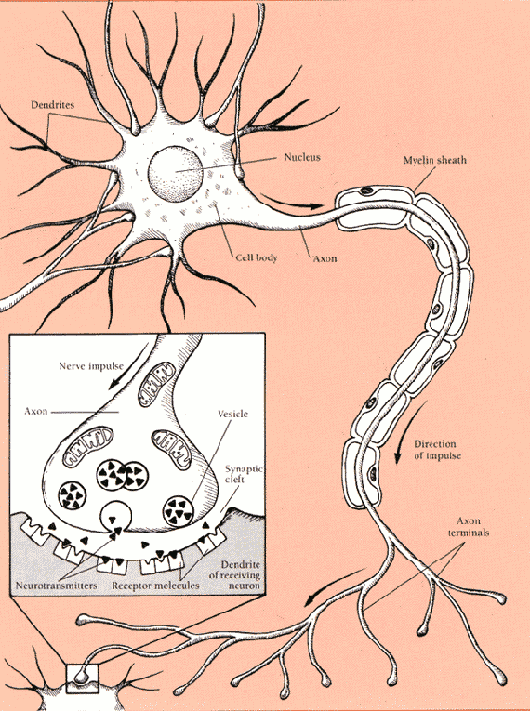

Cell Body
Variable shape and size Contains nucleus. Functions: metabolic machinery of cell (i.e., Protein Synthesis, Metabolism,Energy Production, etc.)
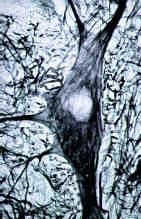
Axon Hillock
site where the axon exits the soma. Functions: establishing the action potential
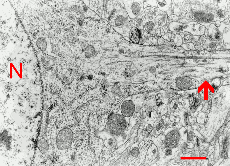
Axon
single long thin extension, (branched in some neurons), constant diameter
Function: electrochemical transmission – sometimes covered with myelin.
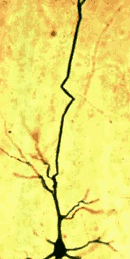
Axon Terminals
swelling at end tip of axonal branch. Functions: Release of neurotransmitters into synapse.

Dendrites
thin branching fibers, spiny or aspiny, decreasing diameter. Functions: inputs- reception of transmissions from adjacent neurons.
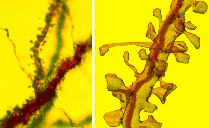
How Neurons Work
Electrochemical process
Propagation of impulse within neuron (electrical).
Transmission of impulse between neurons (chemical).
Resting Potential
Neuron at rest.
Not firing.
Stable, negative charge inside neuron relative to outside (- 70 mV)
(Hyperpolarization)
Where does the resting potential come from?
1. Elemental ions:
K+ (potasium)
Na+ (sodium)
CA++ (calcium)
Cl- (chloride)
2. Elemental forces:
diffusion / concentration gradient
electrical potential (voltage) / electrostatic gradient
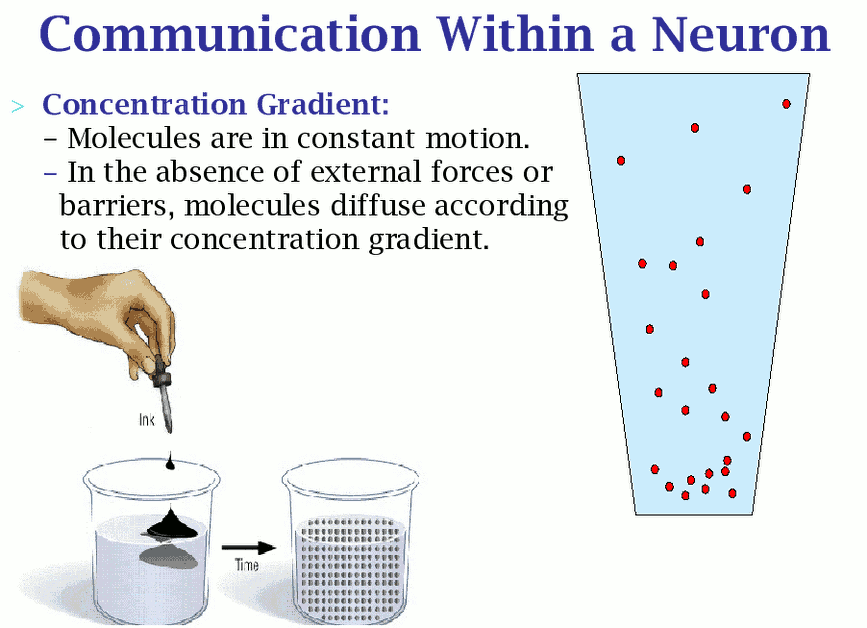

cell membrane at rest is largely impermeable to Na+ ions
although ion channels or ionophores allow some ions through Na/K ion pump – moves 3 Na+ outside moves 2 K+ inside
results in: more (+) ions outside than inside.
The membrane permeability determines resting potential through 2 types of ion channels:
1. gated – let certain ions through under certain circumstances.
2. Non gated – always lets certain ions through, but not fast enough to neutralize the ion pumps.
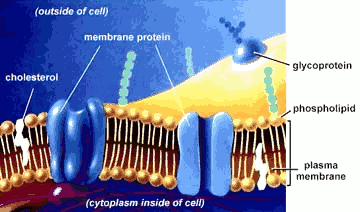
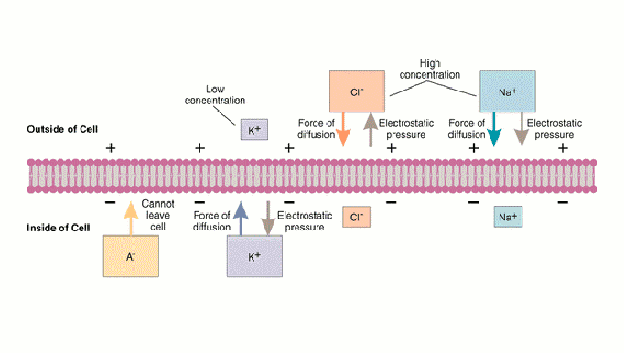

Action Potential
Neuron receives sufficient stimulation from receptor, other neurons, etc.
Na+ ions rush in.
Interior of axon becomes positive relative to the outside (+ 40 mV)
(Depolarization)
This release of energy passes down the axon and is the firing of the neuron.
Once neuron fires, resting potential returns.
Once neuron fires, the impulse moves down the axon at the same intensity.
No stopping it. You either have and action potential or you don't.
Impulse frequency
While there are differences in speed of transmission between neurons, increase in neuron stimulation doesn’t cause stronger impulse. Speed and electrical change remains the same regardless of intensity.
Stronger stimulation leads to more frequent firing of the neuron or more neurons activated.
Absolute Refractory Period
Brief period of time after firing when neuron won’t fire no matter how much stimulation given.
As brief as 1/1000 of a second. HOWEVER, means a limit as to how many times neuron can fire per
second (the maximum is 500-600 times/second).
Think of neuron like a toilet that works well
Information flows in 1 direction (out to the sewage!)
It is all or none – the toilet doesn’t have “half flush” days
There is a period of time that, no matter how much you jiggle the handle, no flushing will occur
Depolarization – resting potential decreases (towards zero and positive numbers) hyperpolarization – resting potential increases (larger negative numbers)
When depolarized past the threshold, the resting potential breaks down.
Voltage-gated Na+ ion channels open and ions flow in along diffusion and electrostatic gradients.
K+ channels then open allowing K ions to flow out.
Gates close and ion pumps restore normal resting potential.
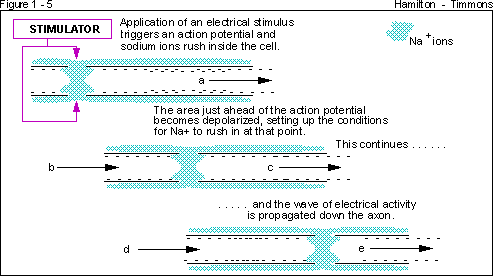
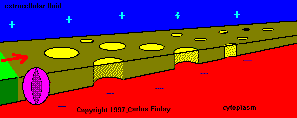
Post synaptic potentials are generated on dendrites ans cell bodies
Action potentials move along the membranes of a neuron. They are initiated at the axon hillock and travel along axons away from the cell body.
Where do action potentials come from naturally?
Sensory neurons
They are generated in cell bodies which depolarize in response to specific stimulation. Called Post Synaptic Potentials (PSP).
The more depolarization, the faster action potentials are generated at the axon hillock.
Neurons do not touch each other
How does activity in one neuron influence activity in another?
Synapses
Presynaptic neuron:
• terminal bouton at the end of axons
• synaptic cleft
Post synaptic neuron contains the receptor sites
Activity at synapses
The arrival of an action potential at terminal causes C++ ion channels to open. This causes the release of a neurotransmitter from synaptic vesicles into the synaptic cleft.
The neurotransmitter interacts with receptor sites located on the surface of large protein molecules. This causes a change in the resting potential of the membrane of the cell body of the post synaptic cell by opening ion channels .
May directly (gated ion channel) or indirectly (second messenger) open ion channels.
Depolarization causes excitation (opens Na+ channels) and increases firing rate. (Excitatory post synaptic potential, EPSP)
Hyperpolarization causes inhibition (opens Cl- channels) and decreases firing rate. (Inhibitory post synaptic potential, IPSP)
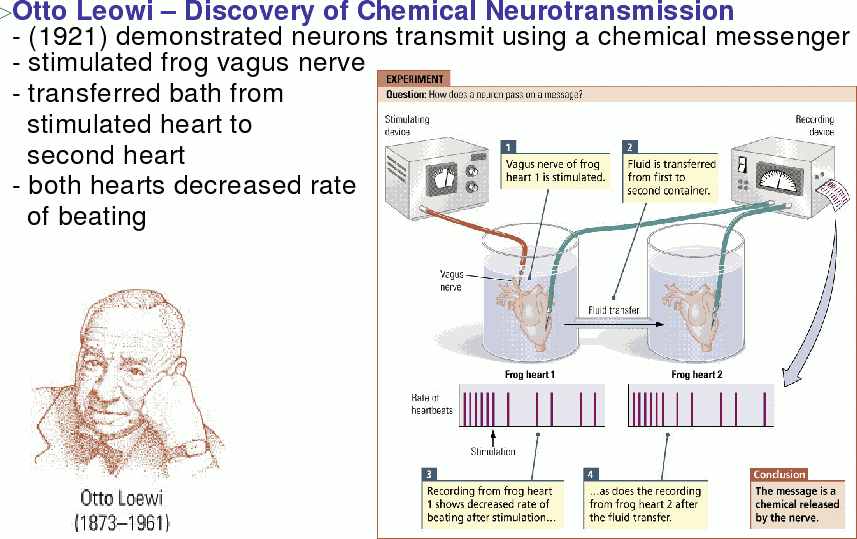
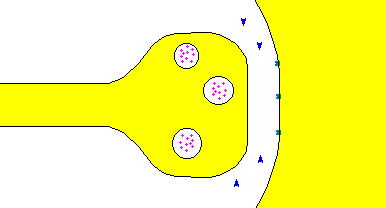
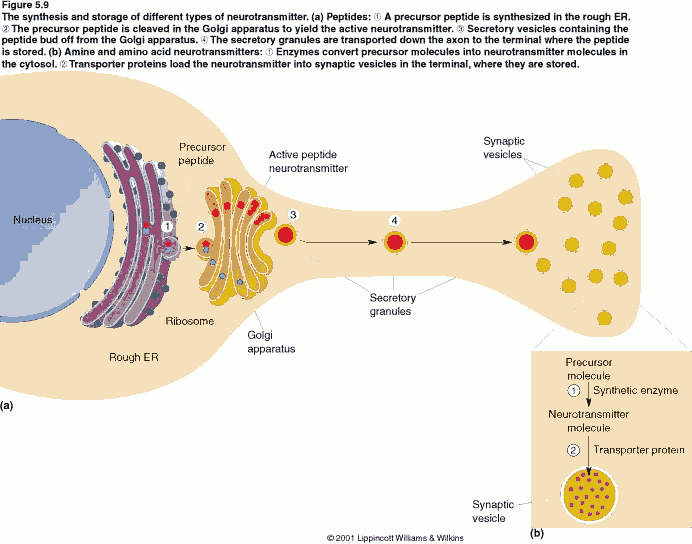
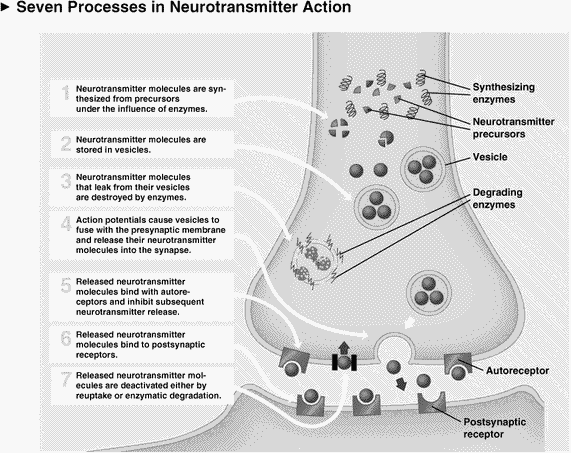
Summation of excitation and inhibition
• spatial
• temporal
Slow, long acting changes
Second messengers
• may open ion channels
• may alter other aspects of cell functioning
Long term changes
Kinases – Longer acting than second messengers
Permanent changes
Transcription factors – alter the expression of DNA and can change the production of ion pumps, ion channels and even synapses.
Neurotransmitters
Transmitter action terminated by reuptake or enzymes.
Neuromodulator: cause changes in reactivity of postsynaptic membrane to other neurotransmitters.
May act internally, or externally
o Acetylcholine
+ motor, learning memory, contract muscles, REM sleep
+ Alzheimers, black widow spider bite
o Dopamine
+ motor, attention, emotions
+ Parkinson’s, schizophrenia, drug abuse
o Norepinephrine
+ regulation of arousal, eating and sleeping
o Serotonin
+ arousal, sleep, learning, mood, aggression, appetite
+ depression
o Endorphins
+ Pain reduction, pleasure
+ possibly related to "runner’s high"